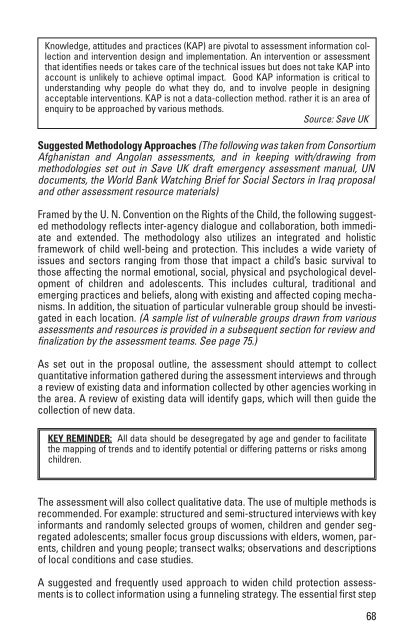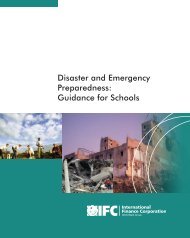Starting Up Child Centered Spaces in Emergencies: A Field Manual
Starting Up Child Centered Spaces in Emergencies: A Field Manual
Starting Up Child Centered Spaces in Emergencies: A Field Manual
- No tags were found...
Create successful ePaper yourself
Turn your PDF publications into a flip-book with our unique Google optimized e-Paper software.
Knowledge, attitudes and practices (KAP) are pivotal to assessment <strong>in</strong>formation collectionand <strong>in</strong>tervention design and implementation. An <strong>in</strong>tervention or assessmentthat identifies needs or takes care of the technical issues but does not take KAP <strong>in</strong>toaccount is unlikely to achieve optimal impact. Good KAP <strong>in</strong>formation is critical tounderstand<strong>in</strong>g why people do what they do, and to <strong>in</strong>volve people <strong>in</strong> design<strong>in</strong>gacceptable <strong>in</strong>terventions. KAP is not a data-collection method. rather it is an area ofenquiry to be approached by various methods.Source: Save UKSuggested Methodology Approaches (The follow<strong>in</strong>g was taken from ConsortiumAfghanistan and Angolan assessments, and <strong>in</strong> keep<strong>in</strong>g with/draw<strong>in</strong>g frommethodologies set out <strong>in</strong> Save UK draft emergency assessment manual, UNdocuments, the World Bank Watch<strong>in</strong>g Brief for Social Sectors <strong>in</strong> Iraq proposaland other assessment resource materials)Framed by the U. N. Convention on the Rights of the <strong>Child</strong>, the follow<strong>in</strong>g suggestedmethodology reflects <strong>in</strong>ter-agency dialogue and collaboration, both immediateand extended. The methodology also utilizes an <strong>in</strong>tegrated and holisticframework of child well-be<strong>in</strong>g and protection. This <strong>in</strong>cludes a wide variety ofissues and sectors rang<strong>in</strong>g from those that impact a child’s basic survival tothose affect<strong>in</strong>g the normal emotional, social, physical and psychological developmentof children and adolescents. This <strong>in</strong>cludes cultural, traditional andemerg<strong>in</strong>g practices and beliefs, along with exist<strong>in</strong>g and affected cop<strong>in</strong>g mechanisms.In addition, the situation of particular vulnerable group should be <strong>in</strong>vestigated<strong>in</strong> each location. (A sample list of vulnerable groups drawn from variousassessments and resources is provided <strong>in</strong> a subsequent section for review andf<strong>in</strong>alization by the assessment teams. See page 75.)As set out <strong>in</strong> the proposal outl<strong>in</strong>e, the assessment should attempt to collectquantitative <strong>in</strong>formation gathered dur<strong>in</strong>g the assessment <strong>in</strong>terviews and througha review of exist<strong>in</strong>g data and <strong>in</strong>formation collected by other agencies work<strong>in</strong>g <strong>in</strong>the area. A review of exist<strong>in</strong>g data will identify gaps, which will then guide thecollection of new data.KEY REMINDER: All data should be desegregated by age and gender to facilitatethe mapp<strong>in</strong>g of trends and to identify potential or differ<strong>in</strong>g patterns or risks amongchildren.The assessment will also collect qualitative data. The use of multiple methods isrecommended. For example: structured and semi-structured <strong>in</strong>terviews with key<strong>in</strong>formants and randomly selected groups of women, children and gender segregatedadolescents; smaller focus group discussions with elders, women, parents,children and young people; transect walks; observations and descriptionsof local conditions and case studies.A suggested and frequently used approach to widen child protection assessmentsis to collect <strong>in</strong>formation us<strong>in</strong>g a funnel<strong>in</strong>g strategy. The essential first step68
















